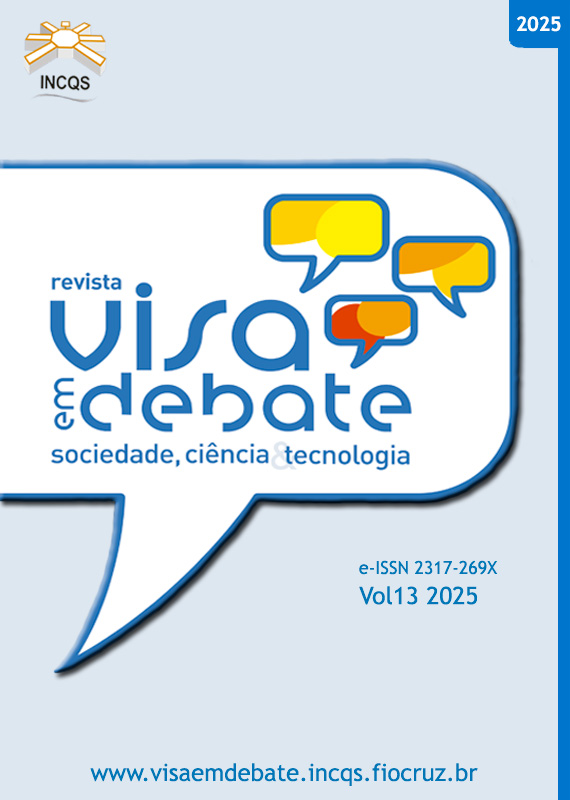Microbial adaptation mechanisms in chicken meat processing and their presence in serovars of salmonellosis cases in Brazil:an integrative review
Vigil Sanit Debate, Rio de Janeiro, 2025, v.13: e02298 | Published on: 26/05/2025
DOI:
https://doi.org/10.22239/2317-269X.02298Keywords:
Non-typhoidal Salmonella, Salmonellosis, Cross-contamination, Antimicrobial Resistance, ChickenAbstract
Introduction: Brazil is the world’s largest exporter of chicken meat. Poultry and poultry products are often associated with non-typhoidal Salmonella (NTS) contamination. Reports on antimicrobial-resistant (AMR) NTS serovars in isolates from Brazilian poultry farms and products are concerning. In response, interventions are implemented in poultry chains to remove microbial contaminants, but they may also exert selective bacterial pressure. Objective: To characterize the adaptation mechanisms occurring in Salmonella throughout chicken meat processing and to determine whether these mechanisms are present in antimicrobial-resistant serovars commonly reported in avian-associated salmonellosis cases in Brazil. Methods: This is an integrative literature review conducted in the PubMed, Embase, Scopus, SciELO, and Web of Science databases. A total of 823 studies were selected between 2017 and 2023. Results: Currently, the primary serovars of NTS isolated from Brazilian poultry products are S. Minnesota and Heidelberg. Antimicrobial resistance genes and multidrug resistance were detected in both serovars. However, there are no official data on cases of antimicrobial-resistant infections in humans caused by S. Minnesota and Heidelberg in Brazil, which complicates the assessment of the impact of these serovars on the country’s public health. Conclusions: The presence of NTS and the substitution of serovars over the past decade have been observed throughout the Brazilian poultry production chain. However, there are no official data identifying the serovars and antimicrobial resistance in cases of salmonellosis in Brazil. This review suggested that this information is crucial for understanding the adaptation of these serovars in poultry processing facilities and for the development of effective strategies to control and prevent the emergence of AMR.
Downloads
Downloads
Published
Issue
Section
License
Copyright (c) 2025 Health Surveillance under Debate: Society, Science & Technology

This work is licensed under a Creative Commons Attribution 4.0 International License.
COPYRIGHT ALLOWANCE The author (s) hereinafter designated as the ASSIGNOR hereby assign and transfer, free of charge, the ownership of the copyrights related to this ARTICLE to the Vigilância Sanitária em Debate: Sociedade, Ciência & Tecnologia (Health Surveillance under Debate: Society, Science & Technology) – Visa em Debate, represented by FUNDAÇÃO OSWALDO CRUZ, established at Av. Brasil, nº 4365, Manguinhos, Rio de Janeiro, RJ, Brazil, CEP 21045-900, under the conditions set out below: (a) The terms and conditions set forth in this Agreement shall apply to the following: 1. The ASSIGNOR declares that they s(he) is (are) the author (s) and owner (s) of the copyrighted property of the ARTICLE submitted. 2. The ASSIGNOR declares that the ARTICLE does not infringe the copyrights and / or other property rights of third parties, that the disclosure of images (if any) has been authorized and that they s(he) assume(s) full moral and / or property liability for its content, before third parties. 3. THE ASSIGNOR assigns and transfers all copyrights relating to the ARTICLE to the ASSIGNEE, especially the rights of editing, publication, translation into another language and reproduction by any process or technique. The ASSIGNEE becomes the exclusive owner of the rights related to the ARTICLE, and any reproduction, totally or partially, is prohibited in any other means of publicity, printed or electronic, without prior written authorization from the ASSIGNEE. 4. The assignment is free and, therefore, there will be no remuneration for the use of the ARTICLE by the ASSIGNEE.







